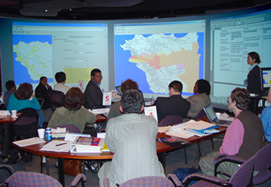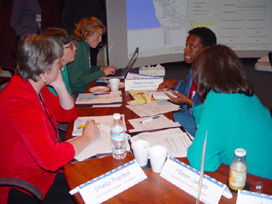|
|
||
| News Center |

|
|
|
|
||
|
|
||
| News Releases | Publications | Resources | Multimedia Gallery | Security Alert Information | ||||
News Release Archive | Awards | ||||
FOR IMMEDIATE RELEASE | ||||
| Alameda County Public Health Department, Sandia researchers simulate anthrax attack on East Bay | ||||
LIVERMORE, Calif. — Locked in a “war room” for a day, representatives from Sandia National Laboratories and 24 other officials, mostly from the Alameda County Public Health Department (ACPHD), teamed up recently in a simulated bioterrorism event to evaluate Alameda County’s ability to respond quickly and effectively to a weapons of mass destruction incident such as anthrax, and to test a disaster response and planning tool designed by Sandia. ACPHD got a chance to experience Sandia’s tool before it is presented at the Centers for Disease Control and Prevention (CDC) in Atlanta this summer. Other participants in the exercise included Contra Costa Health Services, City of Berkeley Public Health Department, Highland Hospital, Kaiser Oakland Hospital, California Department of Health Services (DHS), Alameda County Office of Emergency Services, and the Federal Bureau of Investigation. “The scenario, while vast in scale, was quite realistic,” said Tony Iton, MD, JD, MPH, who participated in the exercise. “The exercise re-emphasized that the core components of bioterrorism response are surveillance, disease control, communication, and coordination. The Sandia folks have developed an excellent tool to help local public health agencies test drive their response plans.” Dr. Iton is the Alameda County Health Officer at ACPHD. Dr. Iton was also pleased to work with such a large collection of bioterrorism experts. “The benefits of the planning process are in establishing relationships and understanding what our various roles are,” he said. It was far more helpful than handing out business cards to collaborative agencies, agreed Jim Morrissey, EMT-P, at ACPHD. “It was much better to actually meet the related disaster staff in-person and to work with them side by side to provide a more efficient, interagency effort with the hopes of then having this become standard in the real events,” he said. “I feel this was a tremendous opportunity to not only test out the Sandia system with them but also to try our combined skills and expertise in a particular type of simulated event.” Morrissey is the disaster coordinator with the Emergency Medical Services division of ACPHD. In a disaster situation, ACPHD coordinates the county-wide medical response, shifting around county staff and resources to stabilize the situation. Sandia and ACPHD got together to test ACPHD’s readiness to respond to a disaster, since Sandia had developed a decision analysis computer program that helps assess bioterrorism preparedness. For this 6-hour drill, participants gathered in Sandia’s Visualization Design Center, where information was displayed and updated via maps, charts, and text on three large screens lining the walls. Representatives from Sandia’s Weapons of Mass Destruction-Decision Analysis Center (WMD-DAC) described an increasingly severe, simulated scenario involving highly infectious, weapon-grade anthrax released in the marina area near Berkeley, California. Participants were asked to imagine that it was January, the weather was cloudy, the country had recently gone from “code orange” to “code red,” and there was a spike in the number of respiratory illnesses in Alameda County. What to do?
Participants, in groups of 4-6 people, had eight minutes to decide how to handle the situation and discuss it in their groups. Groups made numerous decisions, including asking hospitals to be on the alert for unusual symptoms and to reschedule elective surgeries, increasing security in Alameda County, and getting an inventory of prophylactic drugs. But then, the Sandia representative described, the situation got worse. The “spike” turned into 35 cases of similar respiratory illness that were “suspected” to be anthrax. Groups made more serious decisions, including treating the affected individuals with antibiotics, investigating the cases, conducting press briefings, and communicating with the CDC and the state DHS. During the next 24 hours modeled in the scenario — requiring just a few minutes of computer simulation time — the situation got even worse. The 35 cases were confirmed as anthrax and 613 more “suspect” cases were reported. In talking again, groups made many decisions that included holding more press briefings, issuing news advisories, and closing all schools in Alameda County to set up clinics and administer prophylactic drugs. Participants spent the morning in the simulation exercise. They spent the remainder of the day evaluating and reviewing the exercise. ACPHD was not the only group to benefit from the experience. “I feel like we definitely learned a lot,” said Howard Hirano, a Sandia manager who arranged the visit. “And that’s the point of WMD-DAC — to provide a learning tool for decision-makers who are tasked with protecting us and responding to potentially catastrophic events.” Launched in early 2001, the WMD-DAC bioterrorism simulation engages the perspectives of many decision-makers as they seek to deal with a complex event that unfolds over days, having to make decisions along the way with incomplete information. Sandia researchers began with the premise that it was only a matter of time until the U.S. suffered a terrorist attack, and it would be wise to be prepared for one. There are several ongoing projects to test enhancements to the models, according to Hirano. Epidemiological work by Los Alamos National Laboratory and analysis for atmospheric releases created by scientists at Lawrence Livermore National Laboratory are being incorporated. A nuclear terror scenario has also been developed. Another feature in the works is to allow health officials to track the spread of diseases, such as smallpox, that spread person-to-person. Recent news coverage of the rapid worldwide spread of SARS underscores the importance of this capability. In addition to the Bay Area models — including Alameda/Contra Costa County as well as San Francisco — another model involving a simulated bioterrorism attack on the 1.9 million residents of New Mexico is nearing completion. Sandia is a multiprogram laboratory operated by Sandia Corporation, a Lockheed Martin company, for the U.S. Department of Energy. With main facilities in Albuquerque, N.M., and Livermore, Calif., Sandia has major R&D responsibilities in national security, energy and environmental technologies, and economic competitiveness. ACPHD is based in Oakland, Calif.
Photos from this bioterrorism simulation are available upon request. Sandia National Laboratories’ News Center is at http://www.sandia.gov/news-center/index.html. The Sandia Lab News Online Edition is at http://www.sandia.gov/LabNews/LabNews.html. For more information on the Alameda County Public Health Department, please visit www.co.alameda.ca.us/publichealth. Sandia media contact: Mike Janes, mejanes@sandia.gov, (925) 294-2447 | ||||
|
Back to top of page News Releases | Publications | Resources | Multimedia Gallery | Security Alert Information |
||||
|
|
||||
|
|
||||

